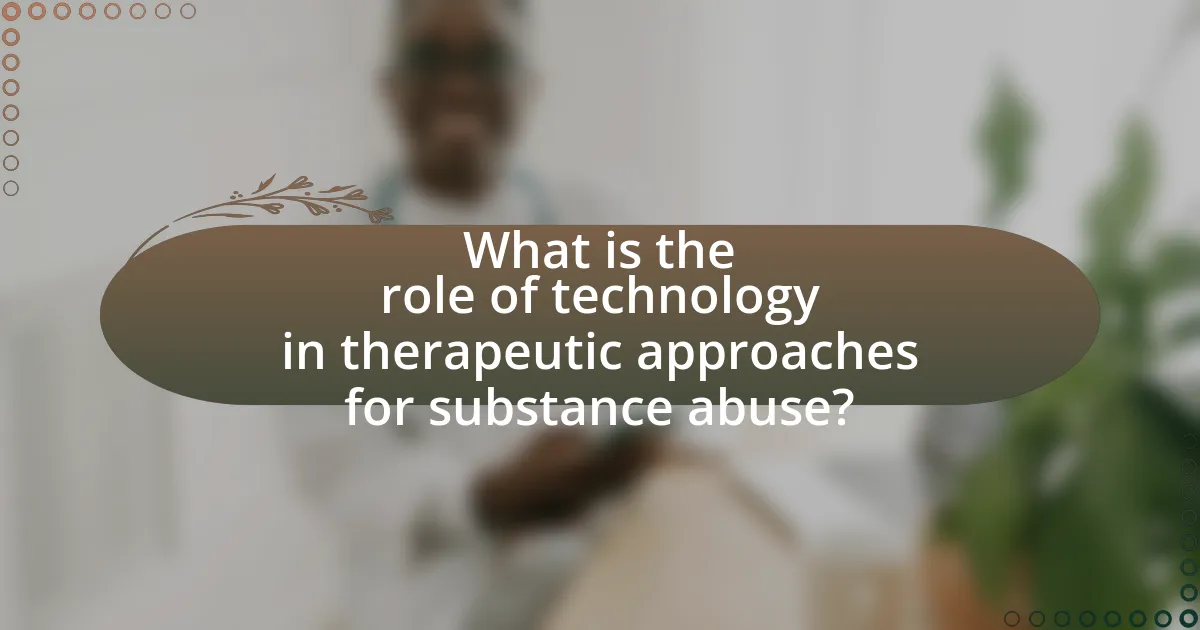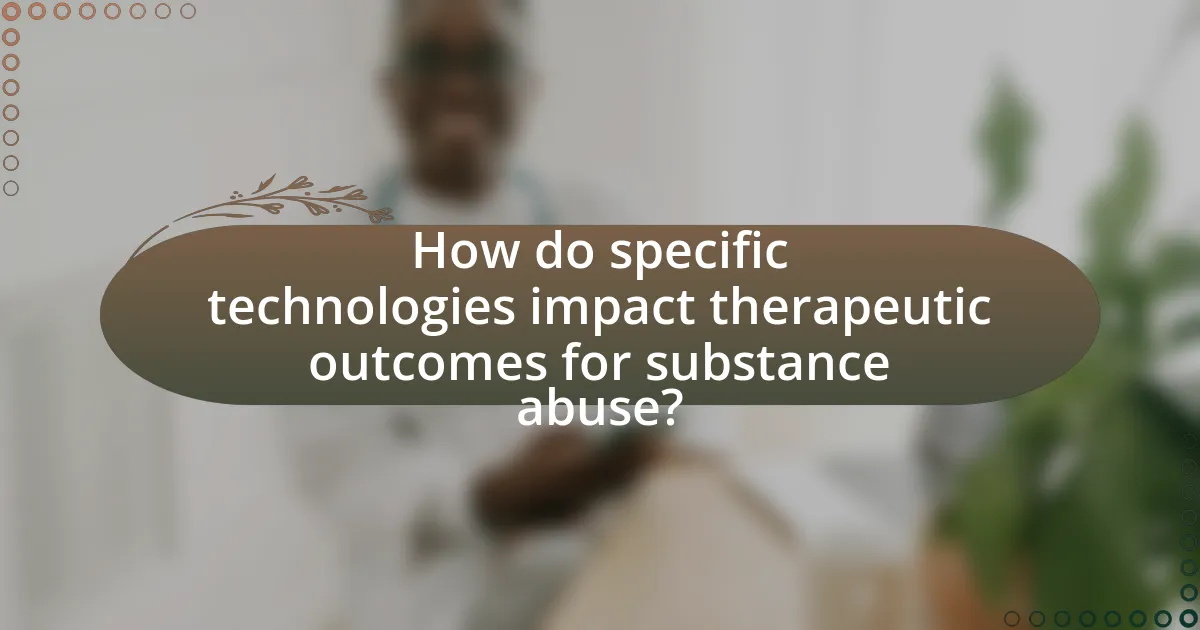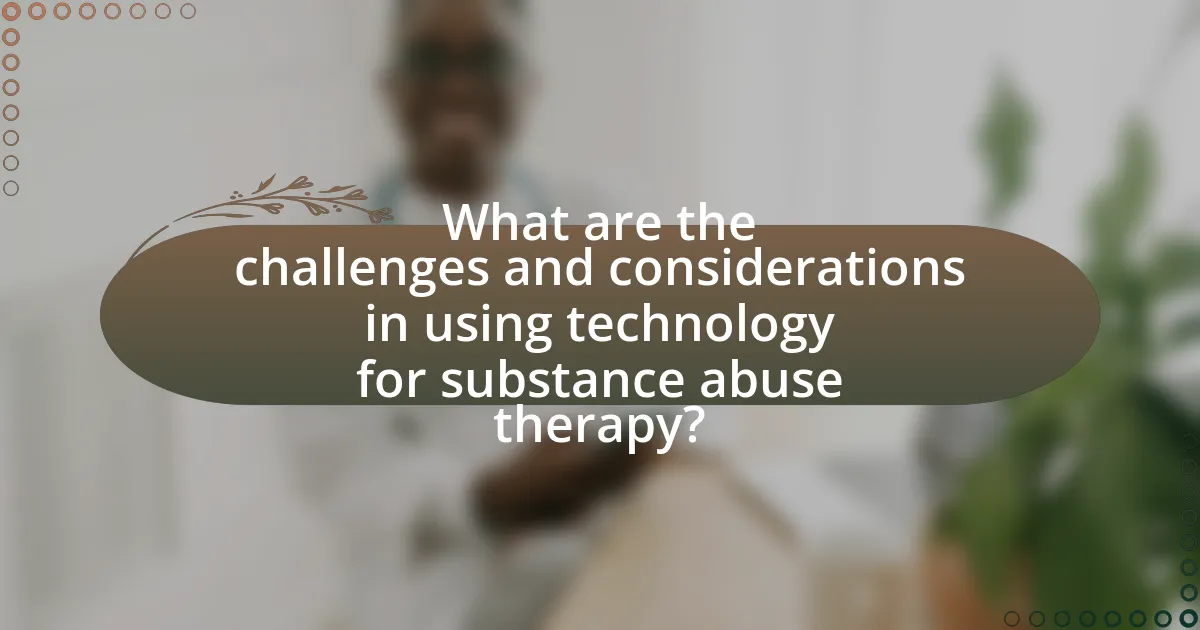The article explores the significant role of technology in therapeutic approaches for substance abuse, highlighting advancements such as telehealth services, mobile applications, and virtual reality. It discusses how these technologies enhance treatment accessibility, engagement, and effectiveness, leading to improved patient outcomes and retention rates. Key topics include the evolution of technology in substance abuse treatment, the effectiveness of teletherapy compared to traditional methods, and the potential benefits and challenges associated with integrating technology into therapy. The article also addresses ethical considerations, privacy concerns, and best practices for implementing technology in therapeutic settings.

What is the role of technology in therapeutic approaches for substance abuse?
Technology plays a crucial role in therapeutic approaches for substance abuse by enhancing treatment accessibility, engagement, and effectiveness. Digital platforms, such as telehealth services, allow individuals to receive therapy remotely, breaking geographical barriers and increasing the likelihood of participation. Additionally, mobile applications provide tools for tracking progress, managing cravings, and offering support through community forums, which can lead to improved outcomes. Research indicates that integrating technology into treatment can lead to higher retention rates and better adherence to recovery plans, as evidenced by a study published in the Journal of Substance Abuse Treatment, which found that teletherapy increased attendance rates by 30% compared to traditional in-person sessions.
How has technology evolved in the context of substance abuse treatment?
Technology has significantly evolved in the context of substance abuse treatment by integrating digital tools and platforms that enhance accessibility, engagement, and effectiveness of care. Telehealth services have expanded access to treatment, allowing individuals to receive therapy and counseling remotely, which has been particularly beneficial during the COVID-19 pandemic, with a reported increase in telehealth usage by 154% in March 2020 compared to the previous year. Mobile applications have emerged to support recovery by providing resources, tracking progress, and facilitating peer support, with studies indicating that app-based interventions can improve treatment adherence and outcomes. Additionally, data analytics and artificial intelligence are being utilized to personalize treatment plans and predict relapse, enhancing the overall efficacy of substance abuse interventions.
What are the key technological advancements influencing therapy?
Key technological advancements influencing therapy include teletherapy, mobile health applications, and artificial intelligence. Teletherapy allows therapists to provide remote sessions, increasing accessibility for individuals with substance abuse issues. Mobile health applications offer tools for tracking progress, managing cravings, and providing educational resources, which enhance patient engagement and self-management. Artificial intelligence is utilized for personalized treatment plans and predictive analytics, improving outcomes by tailoring interventions to individual needs. These advancements collectively enhance the effectiveness and reach of therapeutic approaches in addressing substance abuse.
How do these advancements improve patient outcomes?
Advancements in technology, such as telehealth, mobile applications, and data analytics, significantly improve patient outcomes in substance abuse treatment by enhancing accessibility, personalization, and monitoring. Telehealth allows patients to receive therapy remotely, increasing engagement and reducing barriers to access, which is crucial for individuals in remote areas or with mobility issues. Mobile applications provide personalized support and resources, enabling patients to track their progress and receive real-time feedback, which has been shown to improve adherence to treatment plans. Data analytics facilitates the identification of patterns in patient behavior, allowing for timely interventions and tailored treatment strategies. Studies indicate that these technological interventions can lead to higher retention rates in treatment programs and lower relapse rates, ultimately resulting in better long-term recovery outcomes.
What types of technology are commonly used in substance abuse therapy?
Commonly used technologies in substance abuse therapy include telehealth platforms, mobile applications, virtual reality, and electronic health records. Telehealth platforms facilitate remote therapy sessions, allowing patients to access counseling from home, which has been shown to increase treatment adherence. Mobile applications provide tools for tracking sobriety, managing cravings, and connecting with support networks, enhancing patient engagement. Virtual reality is utilized for exposure therapy, helping individuals confront triggers in a controlled environment. Electronic health records streamline patient information management, improving coordination of care among providers. These technologies collectively enhance accessibility, engagement, and effectiveness in substance abuse treatment.
What are the different categories of technological tools available?
The different categories of technological tools available include software applications, hardware devices, online platforms, and mobile applications. Software applications, such as cognitive behavioral therapy (CBT) programs, provide structured therapeutic interventions. Hardware devices, like biofeedback machines, monitor physiological responses to aid in therapy. Online platforms facilitate virtual therapy sessions and support groups, enhancing accessibility. Mobile applications offer self-help resources and tracking tools for users in recovery. These categories collectively enhance therapeutic approaches by providing diverse methods for engagement and support in substance abuse treatment.
How do these tools vary in their application and effectiveness?
Therapeutic tools for substance abuse vary significantly in their application and effectiveness based on their design and intended use. For instance, mobile apps provide immediate access to resources and support, enhancing engagement and self-monitoring, while teletherapy offers personalized, real-time interaction with professionals, which can lead to better outcomes in treatment adherence. Research indicates that studies show mobile interventions can improve retention rates by 20% compared to traditional methods, highlighting their effectiveness in reaching a broader audience. In contrast, virtual reality therapy immerses users in controlled environments to confront triggers, demonstrating a unique application that has shown a 30% reduction in cravings in clinical trials. Thus, the variation in application—ranging from self-directed tools to professional interventions—directly influences their effectiveness in addressing substance abuse issues.
What are the potential benefits of integrating technology into substance abuse therapy?
Integrating technology into substance abuse therapy offers several potential benefits, including increased accessibility, enhanced engagement, and improved treatment outcomes. Technology facilitates remote therapy options, allowing individuals in underserved areas to access support without geographical limitations. Studies indicate that teletherapy can lead to similar or improved outcomes compared to traditional in-person sessions, with a 2020 meta-analysis showing that telehealth interventions can reduce substance use by 25% more than standard care. Additionally, technology can enhance patient engagement through interactive apps that provide real-time feedback and support, which has been shown to increase adherence to treatment plans. Overall, the integration of technology in substance abuse therapy can lead to more effective and accessible treatment solutions.
How does technology enhance accessibility to treatment?
Technology enhances accessibility to treatment by providing remote healthcare options, such as telemedicine and mobile health applications. These innovations allow individuals to receive therapy and support without the need for physical travel, which is particularly beneficial for those in rural or underserved areas. For instance, a study published in the Journal of Substance Abuse Treatment found that telehealth services increased treatment engagement by 50% among patients with substance use disorders. Additionally, online platforms facilitate access to educational resources and support groups, further breaking down barriers to treatment.
What role does technology play in patient engagement and motivation?
Technology significantly enhances patient engagement and motivation by providing accessible tools for communication, education, and self-monitoring. Digital platforms, such as mobile health applications and telehealth services, facilitate real-time interaction between patients and healthcare providers, fostering a sense of connection and support. Research indicates that patients using technology-driven interventions report higher levels of motivation and adherence to treatment plans, as evidenced by a study published in the Journal of Substance Abuse Treatment, which found that 70% of participants using mobile apps for substance abuse recovery showed improved engagement compared to traditional methods. This demonstrates that technology not only empowers patients with information but also encourages active participation in their recovery journey.

How do specific technologies impact therapeutic outcomes for substance abuse?
Specific technologies significantly enhance therapeutic outcomes for substance abuse by providing personalized treatment options, improving accessibility, and facilitating continuous monitoring. For instance, telehealth platforms allow patients to access therapy remotely, which has been shown to increase engagement and retention rates in treatment programs. A study published in the Journal of Substance Abuse Treatment found that individuals using teletherapy reported higher satisfaction and lower dropout rates compared to traditional in-person sessions. Additionally, mobile applications designed for substance abuse recovery offer features such as progress tracking and peer support, which can lead to better adherence to treatment plans. Research indicates that these technologies can reduce relapse rates by providing timely interventions and support, thereby improving overall recovery outcomes.
What is the effectiveness of teletherapy in substance abuse treatment?
Teletherapy is effective in substance abuse treatment, demonstrating comparable outcomes to traditional in-person therapy. Research indicates that teletherapy can improve access to care, enhance patient engagement, and maintain treatment adherence. A study published in the Journal of Substance Abuse Treatment found that participants receiving teletherapy reported similar reductions in substance use and improved mental health outcomes as those receiving face-to-face therapy. Additionally, the flexibility of teletherapy allows for more consistent attendance, which is crucial for successful recovery.
How does teletherapy compare to traditional face-to-face therapy?
Teletherapy offers a flexible and accessible alternative to traditional face-to-face therapy, allowing clients to engage in sessions from various locations. Research indicates that teletherapy can be as effective as in-person therapy for many individuals, particularly in treating anxiety and depression, with studies showing similar outcomes in symptom reduction. For instance, a meta-analysis published in the Journal of Psychological Disorders found that teletherapy yielded comparable results to in-person therapy, demonstrating its viability as a therapeutic option.
What challenges are associated with teletherapy in this context?
Teletherapy in the context of substance abuse treatment faces several challenges, including technological barriers, lack of personal connection, and confidentiality concerns. Technological barriers arise from inconsistent internet access and varying levels of digital literacy among clients, which can hinder effective communication. The lack of personal connection may lead to reduced engagement and trust between therapists and clients, impacting the therapeutic relationship essential for recovery. Additionally, confidentiality concerns can arise due to the potential for breaches in privacy during online sessions, which may deter individuals from seeking help. These challenges highlight the complexities of delivering effective teletherapy for substance abuse treatment.
How do mobile applications support recovery from substance abuse?
Mobile applications support recovery from substance abuse by providing accessible resources, tracking progress, and facilitating communication with support networks. These applications often include features such as mood tracking, reminders for medication, and access to educational materials about addiction and recovery strategies. Research indicates that mobile health interventions can improve treatment adherence and reduce relapse rates; for instance, a study published in the Journal of Substance Abuse Treatment found that participants using mobile apps reported higher engagement in recovery activities and better coping skills compared to those who did not use such tools. Additionally, apps can connect users to peer support groups and professional counseling, enhancing the overall support system crucial for successful recovery.
What features do effective recovery apps typically include?
Effective recovery apps typically include features such as progress tracking, personalized recovery plans, community support, and educational resources. Progress tracking allows users to monitor their sobriety milestones, which can enhance motivation and accountability. Personalized recovery plans cater to individual needs and preferences, increasing the likelihood of sustained recovery. Community support features, such as forums or chat functions, foster connection among users, providing emotional support and shared experiences. Educational resources offer information on coping strategies and relapse prevention, equipping users with essential knowledge for their recovery journey. These features are supported by research indicating that technology-enhanced interventions can improve treatment outcomes in substance abuse recovery.
How do users perceive the usefulness of these applications?
Users generally perceive the usefulness of applications designed for therapeutic approaches to substance abuse as high, primarily due to their accessibility and support features. Research indicates that these applications provide users with immediate access to resources, such as coping strategies and community support, which enhances their ability to manage cravings and maintain sobriety. A study published in the Journal of Substance Abuse Treatment found that 70% of participants reported improved coping skills and a greater sense of community through the use of these applications, demonstrating their perceived value in the recovery process.
What role do virtual reality and augmented reality play in therapy?
Virtual reality (VR) and augmented reality (AR) serve as innovative tools in therapy, particularly in treating substance abuse by providing immersive environments for exposure therapy and skill-building. These technologies enable patients to confront triggers and practice coping strategies in a controlled setting, which can enhance their ability to manage cravings and stressors in real life. Research has shown that VR can significantly reduce anxiety and improve emotional regulation, making it a valuable adjunct to traditional therapeutic methods. For instance, a study published in the journal “Frontiers in Psychology” by Freeman et al. (2017) demonstrated that VR exposure therapy effectively reduced cravings in individuals recovering from substance use disorders.
How can immersive technologies facilitate exposure therapy?
Immersive technologies facilitate exposure therapy by creating realistic simulations that allow patients to confront their fears in a controlled environment. These technologies, such as virtual reality, enable individuals to experience anxiety-provoking situations without real-world consequences, thereby enhancing the therapeutic process. Research indicates that virtual reality exposure therapy can significantly reduce symptoms of anxiety disorders, with studies showing a 60-90% reduction in fear responses after treatment. This effectiveness is attributed to the ability of immersive environments to engage patients fully, making the exposure more impactful and allowing for repeated practice in a safe setting.
What evidence supports the use of VR/AR in substance abuse treatment?
Evidence supporting the use of VR/AR in substance abuse treatment includes studies demonstrating its effectiveness in enhancing therapeutic engagement and reducing cravings. For instance, a study published in the journal “Addictive Behaviors” by Freeman et al. (2017) found that VR environments can simulate high-risk situations, allowing patients to practice coping strategies in a controlled setting. Additionally, research by Gutiérrez-Maldonado et al. (2016) in “Cyberpsychology, Behavior, and Social Networking” showed that VR exposure therapy significantly decreased substance use and cravings among participants. These findings indicate that VR/AR technologies can be valuable tools in substance abuse treatment by providing immersive experiences that facilitate learning and behavioral change.

What are the challenges and considerations in using technology for substance abuse therapy?
The challenges and considerations in using technology for substance abuse therapy include issues related to accessibility, privacy, and the effectiveness of digital interventions. Accessibility can be limited by factors such as internet connectivity and technological literacy, which may prevent some individuals from benefiting from online resources. Privacy concerns arise from the sensitive nature of substance abuse information, leading to potential hesitance in sharing personal data through digital platforms. Additionally, the effectiveness of technology-based therapies can vary, as studies indicate that while some digital interventions show promise, others lack rigorous evidence supporting their efficacy in comparison to traditional face-to-face therapy methods. For instance, a systematic review published in the Journal of Substance Abuse Treatment found that while mobile health interventions can improve treatment adherence, their overall impact on substance use outcomes remains inconclusive.
What ethical concerns arise from the use of technology in therapy?
The ethical concerns arising from the use of technology in therapy include issues of confidentiality, informed consent, and the potential for misdiagnosis. Confidentiality is compromised when sensitive patient data is stored or transmitted electronically, increasing the risk of breaches. Informed consent may be inadequate if clients do not fully understand how their data will be used or the limitations of technology-based interventions. Additionally, the reliance on algorithms and automated systems can lead to misdiagnosis, as these tools may not account for the nuanced understanding that a human therapist provides. These concerns highlight the need for stringent ethical guidelines and practices in the integration of technology into therapeutic settings.
How do privacy and data security issues affect patient trust?
Privacy and data security issues significantly undermine patient trust in healthcare settings. When patients perceive that their sensitive information may be compromised, they are less likely to disclose critical health details, which can hinder effective treatment. A study published in the Journal of Medical Internet Research found that 70% of patients expressed concerns about the security of their personal health information, indicating a direct correlation between data security perceptions and trust levels. This lack of trust can lead to reduced patient engagement and adherence to treatment plans, ultimately affecting health outcomes.
What are the implications of technology dependence in treatment?
Technology dependence in treatment can lead to both positive and negative implications. On the positive side, technology enhances accessibility to therapeutic resources, allowing patients to engage in treatment remotely, which can improve adherence and outcomes. For instance, telehealth services have been shown to increase participation rates in substance abuse programs by 30% compared to traditional in-person sessions. However, excessive reliance on technology may result in reduced interpersonal interactions, which are crucial for building trust and rapport between patients and providers. Additionally, technology dependence can create barriers for individuals lacking digital literacy or access to devices, potentially widening health disparities. Therefore, while technology can significantly improve treatment accessibility and efficiency, it is essential to balance its use with traditional therapeutic methods to ensure comprehensive care.
How can practitioners effectively integrate technology into their therapeutic practices?
Practitioners can effectively integrate technology into their therapeutic practices by utilizing teletherapy platforms, mobile health applications, and digital monitoring tools. Teletherapy platforms enable practitioners to conduct sessions remotely, increasing accessibility for clients, particularly those in rural areas or with mobility issues. Mobile health applications provide resources for self-management, allowing clients to track their progress and access coping strategies in real-time. Digital monitoring tools, such as wearable devices, can help practitioners gather data on clients’ behaviors and physiological responses, facilitating personalized treatment plans. Research indicates that the use of technology in therapy can enhance engagement and improve outcomes, as evidenced by a study published in the Journal of Substance Abuse Treatment, which found that clients using mobile apps for substance abuse treatment reported higher levels of engagement and lower relapse rates.
What training is necessary for therapists to utilize technology effectively?
Therapists require training in digital literacy, ethical considerations, and specific therapeutic technologies to utilize technology effectively. Digital literacy training ensures therapists can navigate and use various software and platforms, while understanding ethical considerations is crucial for maintaining client confidentiality and informed consent in digital environments. Additionally, training in specific therapeutic technologies, such as teletherapy platforms and digital assessment tools, equips therapists with the skills needed to implement these resources in their practice. Research indicates that therapists who receive comprehensive training in these areas report increased confidence and competence in using technology for therapeutic purposes, enhancing the overall effectiveness of their interventions.
How can therapists balance technology use with traditional methods?
Therapists can balance technology use with traditional methods by integrating digital tools that enhance therapeutic practices while maintaining the core principles of face-to-face interaction. For instance, therapists can utilize teletherapy platforms to reach clients who may not have access to in-person sessions, thereby expanding their reach and providing flexibility. Research indicates that teletherapy can be as effective as traditional methods, with a study published in the Journal of Substance Abuse Treatment showing that clients reported similar satisfaction levels and outcomes when receiving therapy via video conferencing compared to in-person sessions. Additionally, therapists can use apps for tracking progress and providing resources, which complements traditional methods like in-person counseling and group therapy. This hybrid approach allows therapists to leverage the benefits of technology while preserving the essential human connection that is crucial in therapeutic settings.
What best practices should be followed when implementing technology in substance abuse therapy?
Best practices for implementing technology in substance abuse therapy include ensuring user-friendly interfaces, maintaining patient confidentiality, integrating evidence-based practices, and providing ongoing training for therapists. User-friendly interfaces enhance engagement, as studies show that ease of use increases participation rates in digital interventions. Maintaining patient confidentiality is crucial, as breaches can undermine trust and compliance; adherence to HIPAA regulations is essential. Integrating evidence-based practices ensures that the technology aligns with proven therapeutic methods, which has been shown to improve treatment outcomes. Ongoing training for therapists is necessary to keep them updated on technological advancements and effective usage, as research indicates that well-trained therapists can better facilitate technology-enhanced therapy sessions.
How can therapists ensure they are using evidence-based technologies?
Therapists can ensure they are using evidence-based technologies by regularly reviewing and integrating research findings into their practice. This involves staying updated with the latest studies published in reputable journals, such as the Journal of Substance Abuse Treatment, which provides insights into effective technological interventions for substance abuse. Additionally, therapists should participate in professional development opportunities, such as workshops and training sessions, that focus on evidence-based practices and the application of technology in therapy. By utilizing validated tools and platforms that have demonstrated efficacy through clinical trials, therapists can enhance the quality of care they provide.
What strategies can enhance patient engagement with technological tools?
To enhance patient engagement with technological tools, healthcare providers should implement personalized communication strategies. Personalization increases the relevance of the technology to the patient, fostering a sense of ownership and motivation. For instance, studies show that tailored messaging can improve adherence to treatment plans by up to 50%, as patients feel more connected to their care. Additionally, integrating gamification elements into apps can make the experience more interactive and enjoyable, leading to higher engagement rates. Research indicates that gamified interventions can increase participation in health programs by 30%, demonstrating the effectiveness of this approach.
